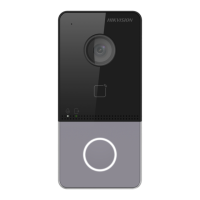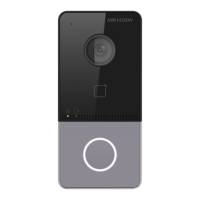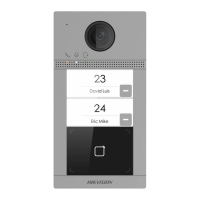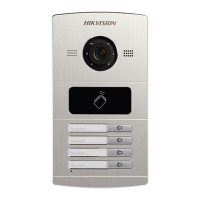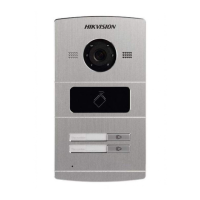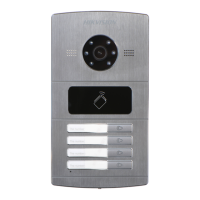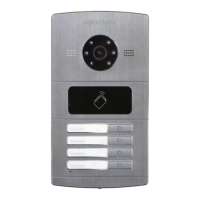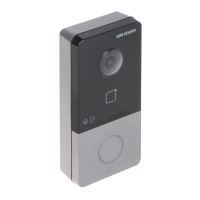
Do you have a question about the HIKVISION DS-KV6113 Series and is the answer not in the manual?
| Audio Bit Rate | 64 Kbps |
|---|---|
| Ingress Protection | IP65 |
| Operation System | Embedded Linux |
| Camera | 2 MP |
| Resolution | 1920 × 1080 |
| Frame Rate | 25/30 fps |
| Video Compression | H.264 |
| Audio Input | Built-in microphone |
| Audio Output | Built-in speaker |
| Network Protocol | TCP/IP, RTSP |
| Interface | 1 RJ45 10/100 Mbps Self-Adaptive Ethernet Interface |
| Relay Output | 1 |
| RS-485 | 1 |
| Power Supply | DC 12V |
| Operating Humidity | 10% to 90% |
| Power Consumption | ≤12 W |
Details the manual's purpose, content, and versioning.
Covers product trademarks and legal disclaimers for usage.
Explains the meaning of danger, caution, and note symbols used in the manual.
Provides essential safety warnings for device operation and installation.
Details FCC compliance, testing, and measures against interference.
States EU conformity and directives for WEEE and battery disposal.
Confirms compliance with Industry Canada standards.
Illustrates and describes components on the front, rear, and bottom panels.
Illustrates the wiring for connecting an electric lock.
Shows the connection diagram for an alarm input device.
Details included accessories and their dimensions for installation.
Steps for surface mounting the device without a protective shield.
Steps for surface mounting the device with a protective shield.
Procedures for activating the device using a web browser.
Procedures for activating the device using client software.
Procedure to modify IP address and gateway via client software.
Accessing and using the live video stream interface.
Managing user and building organization structures.
Configuring local parameters for live view, recording, and images.
Configuring device name, language, time zone, and NTP.
Settings for RS-485 communication.
Procedures for rebooting, restoring, exporting, and upgrading the device.
Managing user permissions and viewing online users.
Configuring the device's IP address, subnet mask, and gateway.
Configuring port numbers, Wi-Fi connection, and SIP parameters.
Configuring SNMP for network monitoring and alerts.
Configuring FTP for file transfer and platform access for mobile management.
Configuring master station, SIP server, and center IP addresses.
Configuring stream type, resolution, bitrate, encoding, and frame rate.
Adjusting input, output, and speak volume levels.
Configuring image brightness, contrast, saturation, sharpness, and WDR.
Customizing OSD text, camera name, and time/date format.
Configuring motion detection areas, sensitivity, and arming schedules.
Configuring access control events and device identification numbers.
Setting door unlock duration and delay alarm.
Configuring elevator control, interface type, and negative floors.
Configuring I/O input and output assignments.
Setting time-related parameters for the device.
Setting ring tones and configuring button call behavior.
Answering incoming calls and searching call history from the door station.
Adding, editing, and managing devices within the client software.
Steps to add devices via online discovery or IP address/segment.
Viewing live video streams and managing organizational structures.
Managing organizations and adding, editing, or deleting persons.
Modifying, deleting, importing, and exporting person data.
Retrieving person data from device and issuing cards in batch.
Creating and applying access permissions for users and devices.
Answering incoming calls and searching call history from the door station.
Filtering and viewing call logs by status, device type, and time.
Enabling device arming and managing alarm uploads to the client.
QR codes for accessing device communication ports and serial port commands.
